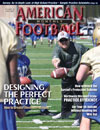AMERICAN FOOTBALL MONTHLY THE #1 RESOURCE FOR FOOTBALL COACHES
|
|
Article Categories
|
Lessons Learned - The Most Important 12 Minutes in Team Sportsby: Chris MatturaVeteran NFL Assistant Coach© More from this issueA good friend of mine once said, “The only meetings that count in football are the ones that take place at halftime.”
Halftime in the National Football League is completely foreign to most people outside the profession. The world of halftime starts in the Laboratory in the Sky (press box) with about three minutes to go in the second quarter. The process begins with each coach talking to another coach through the headset (field) or in the press box as to what offensive plays they like and what schemes they like on the defensive side of the ball. They then are transferred to acetates for presentation at halftime. In addition, charts are complied for the purpose of tendencies as well as what to anticipate.
Once in the locker room, this data is usually posted and/or verbalized by one of the coaches. ....The full article can only be seen by subscribers.
Subscribe today!

|
|
|
NOT A SUBSCRIBER?
Subscribe
now to start receiving our monthly magazine PLUS get INSTANT
unlimited access to over 4000 pages of 100 percent football coaching
information, ONLY available at AmericanFootballMonthly.com!
|
|
|
HOME
|
MAGAZINE
|
SUBSCRIBE
|
ONLINE COLUMNISTS
|
COACHING VIDEOS
|
Copyright 2026, AmericanFootballMonthly.com
All Rights Reserved






